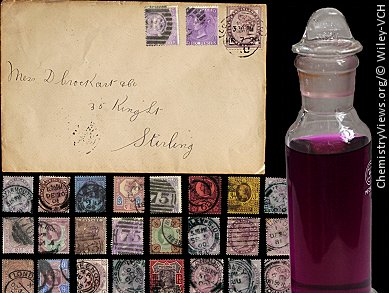Mauveine, also known as aniline purple and Perkin’s mauve, was discovered serendipitously in 1856 by Sir William Perkin. It was the first synthetically made, commercially successful organic dye and is a landmark in the history of the development of organic colourants. In fact, two different synthetic processes were developed for industrial use, one by William Perkin and the other by Heinrich Caro. The dye, however, is no longer commercially available and the last known use was for printing postage stamps.
From a detailed chemical analysis of historical samples of both Perkin’s and Caro’s mauveine, J. Sérgio Seixas de Melo, University of Coimbra, Portugal, and collaborators from Lisbon, Portugal, Swansea, UK, and Durban, South Africa, found that Caro’s mauveine contains a very high percentage of pseudomauveine, whereas Perkin’s mauveine was mainly constituted of mauveine B (C27).
By comparison with samples of Victorian postage stamps, the researchers were able to show that both dyes were employed for the manufacture of a small group of lilac 6d stamps in the period 1867–1880.
- Perkin’s and Caro’s Mauveine in Queen Victoria’s Lilac Postage Stamps: A Chemical Analysis,
M. Conceição Oliveira, A. Dias, P. Douglas, J. Seixas de Melo,
Chem. Eur. J. 2014.
DOI: 10.1002/chem.201303232




